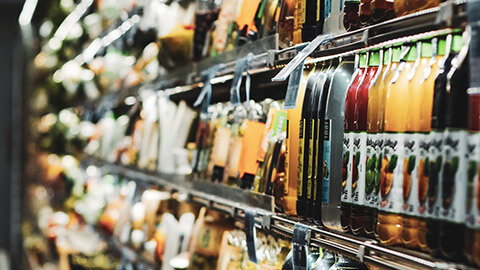Welcome to Topic 8: Near, Far, Wherever They Are. In this topic you will learn about:
- What is place?
- Different types of distribution channels
- The roles of intermediaries
- Selecting channels
- Supporting intermediaries.
Where can you purchase your favourite product and where would you like to purchase the product? Do you prefer going to a physical store or do you prefer to shop online? This topic explores and examines another element within the marketing mix, Place, which refers to the distribution of products. Understanding ways to reach our target market or bring customers to the product is critical for improving sales, market share and developing effective marketing strategies.
These relate to the Subject Learning Outcomes:
- Evaluate market conditions and consumer needs when forming marketing strategies.
- Describe a range of common strategies for use with each of the various marketing mix tools: product, pricing, promotion, and distribution.
- Recommend and justify an appropriate mix of such strategies to form a cohesive overall strategy to address given marketing tasks or situations.
Welcome to your pre-seminar learning tasks for this week. Please ensure you complete these prior to attending your scheduled seminar with your lecturer.
Click on each of the following headings to read more about what is required for each of your pre-seminar learning tasks.
Read Chapter 12 (pp.342-362) of Kotler, P & Armstrong, G 2021, Principles of Marketing Global Edition, 18th edn., Pearson.
Read the following journal articles:
- Rangan, K, Menezes, MAJ & Maier, EP 1992, 'Channel selection for new industrial products: a framework, method, and application', Journal of Marketing, 56(3):69-82.
- Weitz, B & Wang, Q 2004, ‘Vertical relationships in distribution channels: A marketing perspective’, The Antitrust Bulletin, 49(4):859-876.
Read the following web articles and industry reports:
- Tarn, D 2020, The complete guide to choosing the right distribution channels, ReVerb
- Munoz, A 2019, Distribution channels: how to ensure the success of your products, Sales Layer
- Shaw, N 2020, How to win more sales with an optimized distribution strategy, Hubspot
- Edelman, B 2014, Mastering the intermediaries, Harvard Business Review
- Varin, A 2018, 4 tips to helps you choose your distribution channels in industry, TraceParts
- Arora, A, Khan, H, Kohli, S & Tufft, C 2020, DTC e-commerce: How consumer brands can get it right, McKinsey & Company
- Prawira, R 2020, 20 advantages of adopting a direct to consumer business model, G Squared
Read the case study, 'Ulta Beauty: Where the Experience Is Beautiful' on p. 406 of the prescribed text.
Read and watch the topic content.
There are discussion forum activities for this topic, which will enhance your knowledge and give you the opportunity to interact with your peers. You can access the activities by clicking on the following links. You can also navigate to the forum by clicking on 'MKT100 Subject Forum' in the navigation bar for this subject.
- Topic 8: Forum Activity 1 - Reflection
- Topic 8: Forum Activity 2 - Case study

What is place?
The 'place' element of the marketing mix refers to where and how customers can acquire the product. To do this, businesses use distribution channels (also known as marketing channels), which are a set of organisations involved in the process of making a product or service available to the consumer or business user (Kotler & Armstrong 2021). These organisations are also known as intermediaries or more colloquially, middle-people.
The aim of distribution is to ensure that the product reaches the customers, or the customers are brought to the product in the most convenient manner. The following figure shows a number of different routes in getting a product to the customers.
Different types of distribution channels
Indirect channels
When intermediaries are involved in the process of getting products from a producer or manufacturer to consumers, this is known as selling through an indirect channel. An indirect channel could involve a single or multiple intermediaries before the product actually reaches the consumers. These intermediaries within the indirect channel are generally categorised into:
- Retailers
- Wholesalers
- Agents.
Retailers

If you have ever shopped at a grocery store like Coles or Woolworths, you would have bought items from a retailer rather than the companies that make it. A retailer is "an organisation that purchases products for the purpose of reselling them to ultimate consumers" (Pride et al. 2012, p. 343). Retailers often get their products directly from the manufacturer itself or another intermediary such as wholesalers.
Examples of retailers include department stores such as David Jones, supermarkets such as Coles, discount stores such as Kmart, convenience stores such as 7-Eleven, and specialty stores that offer a narrow product line, for example, Sephora for cosmetics and JB Hi-Fi for electronics (Kotler & Armstrong 2021).
As e-commerce grows in popularity, there are also retailers that operate primarily online, for example, Amazon, eBay and Kogan. This is different from buying directly from the official websites of product manufacturers.
Wholesalers
Unlike retailers who sell directly to end consumers, wholesalers are organisations that buy products from manufacturers and sell them to other businesses, either to be resold, used in producing other goods and services, or used in operating the businesses (Rix 2007). Wholesalers deal primarily in business-to-business (B2B) markets and are not consumer-facing. As a result, you may not be aware of their existence but they do play an important role in the distribution channels.
The following video illustrates how a product moves from manufacturers to the customers through retailers, wholesalers and distributors.
Agents
Agents are intermediaries that represent buyers or sellers but they do not own the products like retailers and wholesalers. They are often seen as a bridge or connection between the buyer and the seller (Pride et al. 2012). While retailers and wholesalers earn their cut through markups, which is the difference between the cost and selling price, agents are paid by commissions. The use of agents is popular in travel products, insurance, real estate and education.
Direct channels
A direct channel is the most straightforward distribution method whereby manufacturers sell their own products directly to consumers. This is also known as the direct-to-consumer (DTC) model and it does not involve any intermediaries in the distribution process. The following short clip explains the characteristics of a DTC model.
Farmers selling their crops in markets and jewellers selling their crafts on Etsy are simple examples of selling through a direct channel. Companies wanting to sell directly to their customers can set up their own storefront, hire their own sales force, or start their own e-commerce website, which is arguably the most popular and effective way to reach customers (Campbell 2020).
Read the pre-seminar article by Prawira (2020), which outlines the 20 advantages of adopting a DTC business model. Now, can you think about some risks and limitations of selling products without intermediaries?
Knowledge check
Complete the following four (4) tasks. Click the arrows to navigate between the tasks.
Multichannel
Do businesses have to decide on a direct channel over an indirect channel? Can they have it all? It is not uncommon for businesses to set up multiple marketing channels to reach the end-user, this is known as a multichannel distribution system.
A manufacturer could sell directly to consumers and through different intermediaries such as retailers and wholesalers at the same time. For example, a pair of Levi's jeans could be purchased directly from the physical store, the Levi.com website or indirectly through physical retailers such as Myer and online retailers such as ASOS.
The following video further explains the multichannel distribution strategy and highlights its benefits and drawbacks for businesses.
The roles of intermediaries
Can you imagine if supermarkets or pharmacies did not exist and you had to go to each manufacturer for a particular product? This creates lots of inconvenience for consumers as they have to put in more effort in purchasing products and also for manufacturers as the businesses have to deal with each customer individually.
From the previous figure, we can see that an intermediary offers efficiencies by reducing the number of required transactions and facilitating exchanges between manufacturers and customers. As such, intermediaries provide essential services to both the buyers and the sellers. We will look into some of their roles and functions within the distribution process (Kotler & Armstrong 2021; Rix 2007; Pride et al. 2021):
- Provide marketing information – Businesses entering new markets often partner with local distributors for their knowledge and expertise of the local market (Arnold 2020).
- Selling and promoting – Businesses can expand to different geographic locations through their intermediaries.
- Store and distribute products – Businesses can send their inventory to intermediaries' warehouses and they will handle the rest. The following video shows how Amazon is responsible for storing, packing, and shipping orders as well as handling returns and exchanges.
- Provide financing and share risks – Intermediaries buy products upfront from manufacturers and risk is shared among the parties because manufacturers no longer have ownership of the products.
- Create assortments – By going through retailers, consumers can get an assortment of products, hence their buying efforts are lowered and they are able to compare products easily.
- Make product readily available – As retailers purchase products upfront from manufacturers, they often have stock on hand and in stores, which means consumers can get their products faster.
- Anticipate wants and provide recommendations – Consumers can get better recommendations from intermediaries as they have knowledge and access to a wide range of products.
- Subdivide large qualities of a product – Manufacturers can sell their products in bulk to intermediaries lowering the number of transactions and consumers can purchase single or smaller quantities of a product.
- Offer additional services – For example, Harvey Norman offers extended warranties and product support on top of the manufacturers' warranties.
Marketing intermediaries do much more than simply take a slice of the pie with each transaction.Weedmark 2019
It is easy for us to go ‘cut out the middleperson’ in these transactions. However, from our discussions we can see that intermediaries can facilitate the transactions between manufacturers and customers as well as provide value to customers. These distributions, logistics and support functions must be performed whether or not intermediaries are involved. If intermediaries are eliminated, these functions will be shifted to manufacturers or consumers (Kotler & Armstrong 2021). You can think about utilising intermediaries as outsourcing the distribution function to third parties. It is about who can bring products to customers the most efficiently and effectively.
Selecting channels

As with any marketing decision, thorough consideration must be given by looking at the customers and their needs, wants and preferences while balancing the business objectives. Deciding on whether to involve an intermediary and which intermediary to involve should be governed by the overall marketing strategy because it can have an impact on how businesses create value for customers.
Manufacturers usually sell their products directly to B2B markets because there are fewer potential customers, the order size is larger, and the unit price is higher. This makes it economically feasible for manufacturers to sell direct through their own sales force and potentially achieve a higher profit margin.
Another benefit for selling direct is the ability to foster business relationships with its customers. B2B products that are highly technical also might not be suitable to be sold via wholesalers and retailers because intermediaries might not have the know-how and motivation to support customers (Rix 2007).
The nature of the products can influence the choice of distribution channels. For instance, perishable products often employ shorter channels to get to the consumers quicker (Pride et al. 2012). The channels of distribution must also have the capability to provide special handling of the product, in this example, that would be refrigeration (Shapiro 1977).
A distribution channel can also influence the image and positioning of a company. While Gucci is sold through retailers, there are only a handful of retailers that are selected. Seeing Gucci sold on Net-a-Porter, a luxury online retail platform will not raise eyebrows, but can you imagine seeing Gucci stocked on the shelves of a Target store? What messages would it send and do you believe the intermediary is a good fit?
Supporting intermediaries
When working with intermediaries, it is important for us to support, encourage and motivate them in order to build a mutually beneficial partnership. For us to succeed, we must first ensure our intermediaries succeed. As suggested by Rix (2007), some ways for businesses to support their intermediaries include:
- Setting acceptable profit margins
- Offering periodic incentives
- Offering advertising allowances
- Providing sales tools such as promotional materials
- Providing sales and end-user training.
As intermediaries often deal with multiple manufacturers, channel partner incentive programmes are increasingly popular to build loyalty. Read the article by Hofacker (2021), Channel partner incentive program, which outlines the benefits of providing incentives to intermediaries and examples of the different types of incentives available.
Knowledge check
Complete the following three (3) tasks. Click the arrows to navigate between the tasks.
Key takeouts
Congratulations, we have made it to the end of the eighth topic! Some key takeouts from Topic 8:
- Place refers to distribution channels, which is how businesses get their products to customers.
- Businesses can choose to sell direct to consumers or indirect through intermediaries such as retailers, wholesalers and agents.
- Businesses can choose to sell over multiple distribution channels, both direct and indirect, and this is known as a multichannel distribution system.
- Intermediaries play an important role to both manufacturers and consumers.
- Selecting whether to sell direct or indirect and which specific intermediaries involve considering multiple factors such as the product and market characteristics.
- Businesses who work with intermediaries must support, encourage and motivate them.
Welcome to your seminar for this topic. Your lecturer will start a video stream during your scheduled class time. You can access your scheduled class by clicking on ‘Live Sessions’ found within your navigation bar and locating the relevant day/class or by clicking on the following link and then clicking 'Join' to enter the class.
Click here to access your seminar.
The learning tasks are listed below. These will be completed during the seminar with your lecturer. Should you be unable to attend, you will be able to watch the recording, which can be found via the following link or by navigating to the class through ‘Live Sessions’ via your navigation bar.
Click here to access the recording. (Please note: this will be available shortly after the live session has ended.)

In-seminar learning tasks
The in-seminar learning tasks identified below will be completed during the scheduled seminar. Your lecturer will guide you through these tasks. Click on each of the following headings to read more about the requirements for each of your in-seminar learning tasks.
The rapid growth of the e-commerce market has unlocked a new breed of companies that operate solely on the Direct-to-Consumer (DTC) model because the internet has made it easier for them to reach consumers without the need for intermediaries. Popular DTC brands include Dollar Shave Club, Koala and Silvi. These brands do not own any physical stores nor will you find them in retail stores.
With lower foot traffic to physical stores expected over the years, the DTC model has been increasingly adopted by legacy brands that have traditionally relied on wholesalers and retailers to sell their products. For example, PepsiCo recently launched its own e-commerce website where customers can purchase a variety of Pepsi's food and beverage brands directly (DeLaite 2021).
Is this a sign of something to come?
To start, select a company from the following two (2) options and access the web links to look at how the business has started with or pivoted to the DTC model. Working in a breakout room assigned by your lecturer during the scheduled seminar, answer the three (3) questions below in relation to your chosen industry. Your lecturer will request that you present the findings back to the class:
Option 1: Warby Parker
- How Warby Parker disrupted then adopted brick-and-mortar retail
- Going public, Warby Parker needs to focus the brand beyond eyewear
- Why digital retail darlings Warby Parker and Allbirds are betting big on stores to grow ahead of public debuts
- Over 400 startups are trying to become the next Warby Parker
Option 2: Nike
- Nike's new business strategy
- The balance in Nike's business is shifting dramatically
- It's getting harder to find Nikes—and that's just how Nike wants it
- 3 reasons to Love Nike's reported decision to cut ties with wholesalers
Questions
- How has the DTC model benefited the company? And in what ways?
- Digitally native companies are going into physical stores and traditional brands competing in retail spaces have turned to e-commerce. What do you believe is the catalyst of this change?
- How do companies ensure a seamless experience across multiple channels (stores and online)?
In this learning task, you will put what you have learned into practice and determine the best distribution strategies for an organisation of your choice in the same breakout room as before. Here are some guiding questions which will inform your distribution strategy:
- Where and how does your target market like to shop?
- Should you have multiple distribution channels?
- What are some shortlisted intermediaries that you will work with, if any?
- How do you support your intermediaries?
Your lecturer will request that you present the findings back to the class.
Welcome to your post-seminar learning tasks for this week. Please ensure you complete these after attending your scheduled seminar with your lecturer. Your lecturer will advise you if any of these are to be completed during your consultation session.
Click the following headings to learn more about your post-seminar learning tasks.
Reflect on this topic. Prepare a list of key terms with their definitions and summarise the key points in your own words. Share these with your lecturer in your reflective journal.
You can also access the reflective journal by clicking on ‘Journal’ in the navigation bar for this subject.
Review the requirements for Assessment 3 and develop questions you have for your lecturer. Begin formulating your marketing strategies by looking at the market analysis you have completed previously and identify any specific opportunities or threats.
Each week you will have a consultation session, which will be facilitated by your lecturer. You can join in and work with your peers on activities relating to this subject. These session times and activities will be communicated to you by your lecturer each week. Your lecturer will start a video stream during your scheduled class time. You can access your scheduled class by clicking on ‘Live Sessions’ found within your navigation bar and locating the relevant day/class or by clicking on the following link and then clicking 'Join' to enter the class.
Click here to access your consultation session.
Should you be unable to attend, you will be able to watch the recording, which can be found via the following link or by navigating to the class through ‘Live Sessions’ via your navigation bar.
Click here to access the recording. (Please note: this will be available shortly after the live session has ended.)

- Fites, DV 1996, Make your dealers your partners, Harvard Business Review,
- Sonntag, M n.d., Product distribution strategy: The ultimate guide [infographic],
References
- Arnold, D 2000, Seven rules of international distribution, Harvard Business Review, https://hbr.org/2000/11/seven-rules-of-international-distribution
- Arora, A, Khan, H, Kohli, S & Tufft,C 2020, DTC e-commerce: How consumer brands can get it right, McKinsey & Company, https://www.mckinsey.com/business-functions/marketing-and-sales/our-insights/dtc-e-commerce-how-consumer-brands-can-get-it-right
- Campbell, P 2020, What is direct to consumer (DTC) & why it's the better retail business model, ProfitWell, https://www.profitwell.com/recur/all/direct-to-consumer/guide
- Delaite, B 2021, Traditional brands shift to DTC to combat lack of retail traffic, Forbes, https://www.forbes.com/sites/forbescommunicationscouncil/2021/03/05/traditional-brands-shift-to-dtc-to-combat-lack-of-retail-traffic/?sh=16873a136a38
- Edelman, B 2014, Mastering the intermediaries, Harvard Business Review, https://hbr.org/2014/06/mastering-the-intermediaries
- Hofacker, M 2021, Channel partner incentive program ideas to energize partners, ReferralRock, https://referralrock.com/blog/channel-partner-incentive-program/
- Kotler, P & Armstrong, G 2021, Principles of Marketing Global Edition, 18th edn., Pearson.
- Munoz, A 2019, Distribution channels: how to ensure the success of your products, Sales Layer, https://blog.saleslayer.com/distribution-channels-how-to-ensure-the-success-of-your-products
- Prawira, R 2020, 20 advantages of adopting a direct to consumer business model, G Squared, https://www.gsquared.com.au/blog/advantages-direct-to-consumer-business-model/
- Pride, WM, Ferrell, OC, Lukas, BA, Schembri, S & Niininen O 2021, Marketing principles, Asian Pacific edn, Cengage Learning.
- Rangan, K, Menezes, MAJ & Maier, EP 1992, 'Channel selection for new industrial products: a framework, method, and application', Journal of Marketing, 56(3):69-82.
- Rix, P 2007, Marketing: a practical approach, 6th edn., McGraw Hill.
- Shapiro, BP 1977, Improve distribution with your promotional mix, Harvard Business Review, https://hbr.org/1977/03/improve-distribution-with-your-promotional-mix
- Shaw, N 2020, How to win more sales with an optimized distribution strategy, Hubspot, https://blog.hubspot.com/sales/optimized-distribution-strategy
- Tarn, D 2020, The complete guide to choosing the right distribution channels, ReVerb, https://reverbico.com/blog/distribution-channels/
- Varin, A 2018, 4 tips to helps you choose your distribution channels in industry, TraceParts, https://info.traceparts.com/blog/4-tips-helps-choose-distribution-channels-industry/
- Weedmark, D 2019, 4 types of marketing intermediaries, Chron, https://smallbusiness.chron.com/4-types-marketing-intermediaries-24330.html
- Weitz, B & Wang, Q 2004, ‘Vertical relationships in distribution channels: a marketing perspective’, The Antitrust Bulletin, 49(4):859-876.

